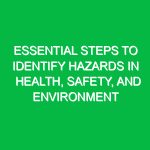Welcome and Purpose
Good morning, team! Thank you for gathering here today for our Toolbox Talk. The focus of our discussion will be on Rationalizing Unsafe Choices within the Health, Safety, and Environment (HSE) domain. As we prepare to start our workday, it’s crucial that we understand how our decisions impact our Safety and that of our colleagues. Today, we’ll unpack the reasons behind unsafe choices, how to recognize them, and the steps we can take to foster a culture of Safety at our workplace.
Understanding Rationalizing Unsafe Choices
So, what do we mean by Rationalizing Unsafe Choices? It refers to the tendency to justify unsafe actions or behaviors based on perceived Benefits, convenience, or pressure. For example, an employee might skip wearing proper Personal Protective Equipment (PPE) because they believe it slows them down, or they might take shortcuts that compromise safety because “everyone else is doing it.”
These rationalizations often lead to accidents, injuries, or even fatalities. It’s essential to recognize these patterns and address them head-on to maintain a safe working environment.
The Psychology Behind Unsafe Choices
Understanding the psychology behind unsafe choices is vital. Many factors can lead to rationalizations, including:
- Peer Pressure: Employees may feel compelled to conform to the behaviors of their coworkers.
- Time Constraints: Tight deadlines can lead to hasty decisions that overlook safety protocols.
- Complacency: Repeated exposure to low-risk situations can create a false sense of security.
- Miscommunication: Lack of clear instructions or information can lead to unsafe choices.
Real-Life Examples of Unsafe Choices
Let’s consider some real-life scenarios:
Scenario 1: Skipping PPE
Imagine a construction worker who decides not to wear a hard hat while on-site because they feel it’s unnecessary for “just a quick job.” This choice could lead to severe injury if something were to fall. The worker might rationalize their decision by thinking they have done similar tasks without an incident before. However, the risk is always present, and one small lapse in judgment can have catastrophic consequences.
Scenario 2: Taking Shortcuts
In another case, a Maintenance technician may choose to bypass a lockout/tagout procedure when servicing equipment to save time. They may think, “I’ll be quick; it’s not going to hurt.” This kind of thinking neglects the serious Hazards involved, such as equipment unexpectedly starting and causing injury. Each of these decisions, while seemingly minor at the moment, can lead to devastating outcomes.
Identifying Unsafe Choices
Now that we’ve discussed some examples, how can we identify when we are rationalizing unsafe choices? Here are some warning signs:
- Feeling Rushed: When you feel pressured to complete a task quickly, pause and evaluate your options.
- Ignoring Safety Protocols: If you find yourself thinking, “It’s easier to skip this step,” take a moment to reconsider.
- Justifying Risks: If you catch yourself saying, “It’s probably fine,” challenge that thought.
Best Practices to Avoid Unsafe Choices
To prevent rationalizing unsafe choices, we must adopt Best Practices that reinforce our commitment to safety:
- Adhere to Safety Protocols: Always follow established Procedures, even if they seem cumbersome.
- Utilize PPE: Wear the appropriate protective gear for each task, regardless of how trivial it may seem.
- Communicate Openly: Encourage team members to speak up if they see unsafe behaviors or practices.
- Take Breaks: Regular breaks can help reduce fatigue, which often leads to poor decision-making.
- Continuous Training: Participate in ongoing safety training to reinforce Safe Practices.
Engaging the Team: Open Discussion
Let’s take a moment to engage in an open discussion. Here are some questions to consider:
- Can anyone share a time when they felt pressured to make an unsafe choice? What happened?
- How do you think we can better support one another in making safe decisions?
- What additional resources or training do you feel could help us combat rationalizing unsafe choices?
Regulations and Standards
It’s important to note that our commitment to safety is not just a matter of personal responsibility; it’s also a legal obligation. Familiarize yourself with relevant Regulations and standards, such as:
- Occupational Safety and Health Administration (OSHA) regulations, which set forth safety standards.
- Company-specific policies that outline safety protocols and procedures.
- Industry Best Practices that guide our safety initiatives.
Compliance with these regulations is crucial, as it not only protects us from legal repercussions but also fosters a culture of safety within our workplace. Remember, safety is a shared responsibility.
Conclusion: The Path Forward
In conclusion, rationalizing unsafe choices can lead to dire consequences, both for individuals and our team as a whole. By recognizing the factors that contribute to these choices and implementing best practices, we can create a safer work environment for everyone.
Thank you all for your attention and your commitment to making safety a priority in our daily operations. Let’s take what we’ve discussed today and apply it on the job site. Remember, safety begins with each of us making conscious, informed choices every day.


